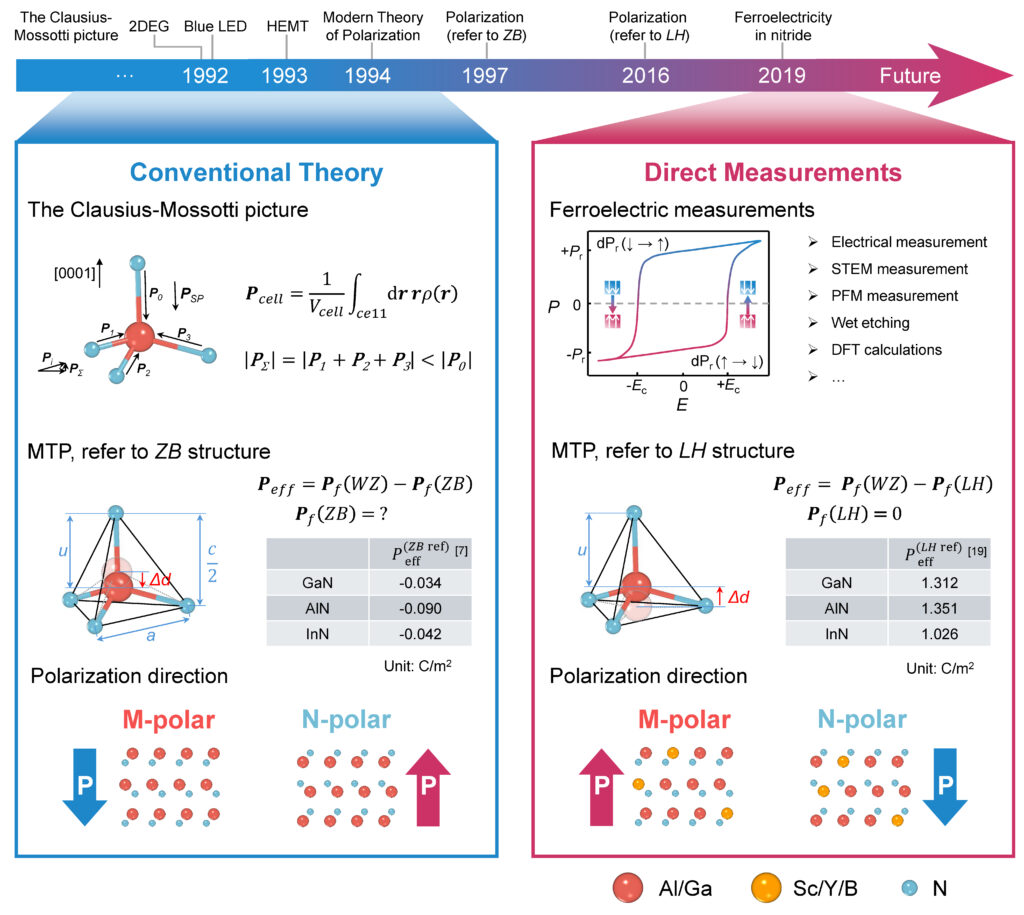Updating the textbook on polarization in gallium nitride to optimize wide bandgap semiconductors

An updated model reconciles the gap between recent experiments and theory concerning polarization in wurtzite semiconductors—paving the way for the development of smaller, faster and more efficient electronic devices, according to a recent study by University of Michigan researchers.
The second most produced semiconductor behind silicon, gallium nitride is already widely used in LED lighting and high power, high frequency electronic devices. The material is expected to transform the next generation of cell phones and communications systems, and polarization underpins its stellar electronic performance.
“Gallium nitride semiconductors are already everywhere in our daily life and the impact is going to continue to grow,” said Zetian Mi, a professor of electrical and computer engineering at U-M and senior author of the study published in Applied Physics Letters.
Here, the research team focused on gallium nitride’s wurtzite crystal structure—the most commonly used phase for electronic and optoelectronic devices. The hexagonal lattice formation of the crystal lacks inversion symmetry, which prompts spontaneous polarization and when mechanical strain is applied, known as piezoelectric polarization.
Both types of polarization, and more importantly, the resulting polarization gradient at the interface, can be harnessed to optimize the electronic properties of semiconductor devices.
Up until recently, polarization in gallium nitride and other wurtzite materials was only understood through theoretical modeling. Then, experiments found that the spontaneous polarization is about 10 times larger and in the opposite direction compared to what previous theory suggested.
Combining the physics and properties of III-nitride materials and ferroelectricity, we can develop the next generation of electronics and optoelectronics with higher power, capacity and speed to better support our world.
Ding Wang
An incorrect reference structure was the root of the large discrepancy between theory and experiments. Previous theory used zinc blend as a reference structure, but when replaced with a hexagonal reference structure, experiments and theory agreed very well.
“Past theory chose an inadequate ruler to measure polarization which led them to obtain the incomplete results. By finding the right ruler, Professor Chris Van de Walle at the University of California Santa Barbara obtained the drastically different results theoretically in 2016, which are now experimentally confirmed by us, as well as others,” said Danhao Wang, a research fellow in electrical and computer engineering at U-M and co-corresponding author of the study.
The researchers arrived at the new standard by sifting through literature and correlating findings with experimental studies that directly measured ferroelectricity—spontaneous polarization that can be reversed when an external electric field is applied—in single crystalline ferroelectric III-nitride semiconductors.
Previously, separate communities of researchers studied ferroelectricity and III-nitride materials—boron, aluminum, gallium or indium combined with nitrogen—and designed applications for those properties in isolation. Mi’s research group recently demonstrated, for the first time, ferroelectric switching in single crystalline nitride semiconductors.

“Combining the physics and properties of III-nitride materials and ferroelectricity, we can develop the next generation of electronics and optoelectronics with higher power, capacity and speed to better support our world,” said Ding Wang, an assistant research scientist of electrical and computing engineering at U-M and co-corresponding author of the study.
These studies provide new direction and insight for gallium nitride-based electronic or optoelectronic devices.
“Beyond electronics and optoelectronics, this new understanding of polarization is an important resource to develop novel nitride-based materials and devices for future clean energy catalysis as well as quantum research and technology,” said Mi.
This work was supported by the National Science Foundation (grant no. 2235377) and the College of Engineering, University of Michigan.
Additional co-author: Samuel Yang of the University of Michigan.
Full citation: “Rethinking polarization in wurtzite semiconductors,” Ding Wang, Danhao Wang, Samuel Yang, and Zetian Mi, Applied Physics Letters (2024), DOI: 10.1063/5.0212653
 MENU
MENU 
